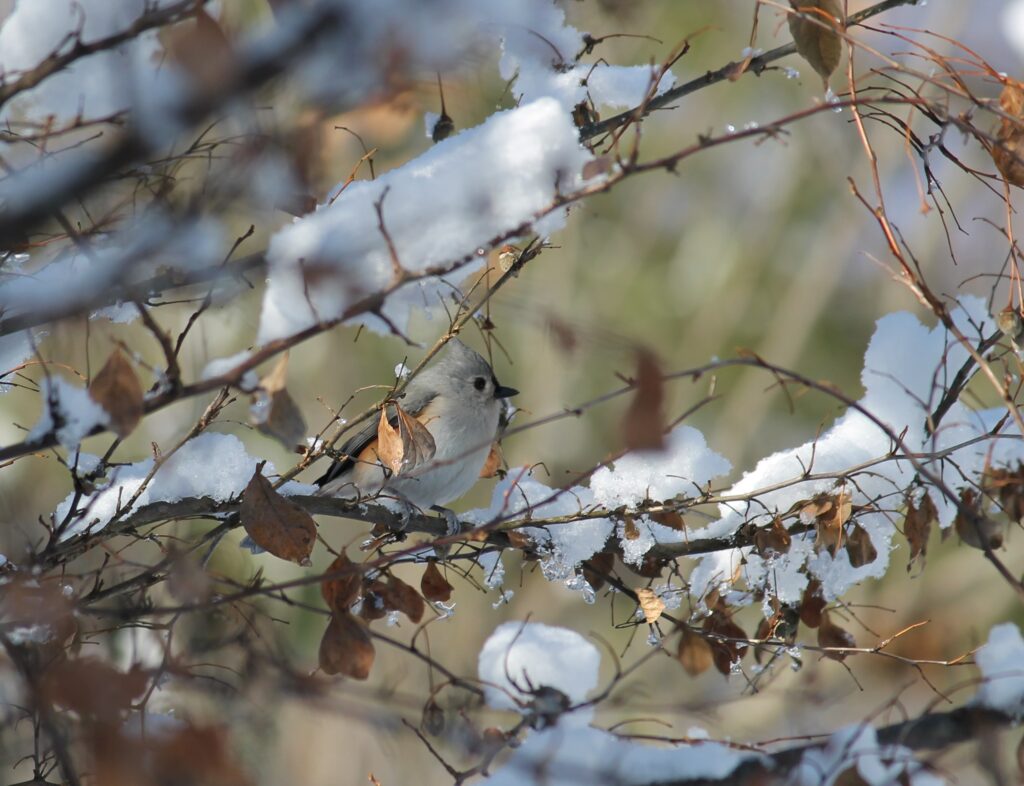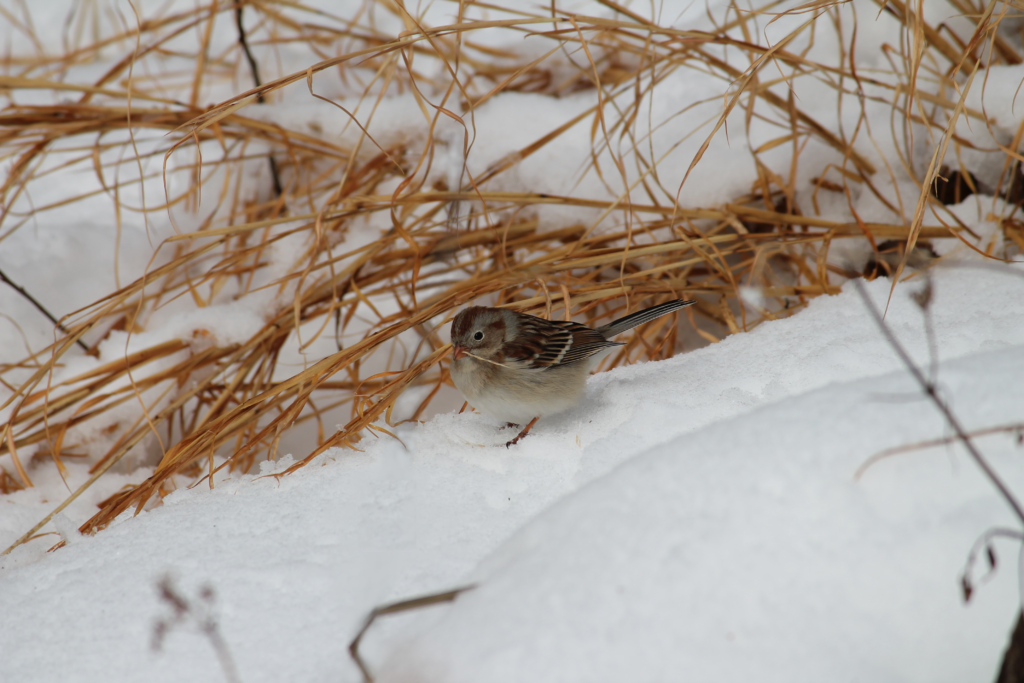Birds add beauty, movement, and color to your landscape. And like all creatures, they need shelter, water, and food to survive. So invite birds to your property this winter by providing these things for our feathered friends.
Create Shelter
Of the three elements necessary for birds, providing shelter is probably the easiest. While bird houses may be purchased or built, they are really a substitute for habitat that is no longer available, such as dead trees, or snags. If you have a dead tree on your property, remove dangerous branches and leave the trunk standing. In addition to providing shelter, chickadees, titmice, nuthatches, creepers, and woodpeckers look for food under the bark of these decaying trees. Another way to provide shelter is to include a variety of shade trees, evergreens, and shrubs in your landscape. This way, you will invite different bird species that nest and perch in these different parts of the landscape. Evergreens and shrub borders are especially important in the winter months, giving songbirds places to escape predators such as hawks and cats.

Provide Water
Water is the next element. If you are lucky enough to have a stream or pond on your property, that is all you need. If you do not have a natural source of water on your site, add a water feature. View birds up close by placing a simple bird bath with a water heater near the house. During the few winter weeks in Pennsylvania when the temperatures remain below freezing, this makes a big difference to the birds. They gather around offerings of water and thank us with their presence, while we watch them from the warmth of our homes.
Invite Birds With Food
Use a variety of foods, places to forage, and native plants to ensure birds have enough to eat in winter.
Variety
Although food is not difficult to provide, not all of our birds eat the same things. Provide a variety of foods to invite birds. This ensures that all of your winter visitors find something to eat. Species with thick bills, such as cardinals, have no problem eating seeds and nuts, while others prefer fruit and insects. Orioles, tanagers, thrushes, thrashers, wrens, cedar waxwings, vireos, and warblers eat soft foods and crave things like suet and peanut butter or other fat-based products, as well as mealworms and fresh and dried fruit. So along with your typical seed feeders, suet feeders and trays of dried fruit are a great winter addition to your yard.

Forage
Providing forage is an easy way to invite birds. Simply set aside areas of your property where birds can find insects and other food. One way to do this is to Leave the Leaves. Many insects overwinter in fallen leaves, so push leaves into garden beds or along property lines and allow ground birds such as sparrows and juncos to do a little hunting. Watch these little birds hop around in leaves searching for these insects. Another benefit to keeping some leaves is that you will be providing habitat for some of our beneficial insects, such as native lady bugs, in which to overwinter. And finally, these fallen leaves are good for the soil as they decompose.
Stick piles and fallen branches also invite birds by providing a place to forage. Artfully arrange piles of sticks or hide them from view. Either way, you will see little birds, especially wrens, darting in and out while looking for something to eat. Line paths with fallen branches, or simply leave them on the ground for visual interest, to provide places for insects to hide, and birds to hunt.

Another easy way to provide places for birds to forage is to leave your perennials standing throughout the winter. Black-eyed Susans, sunflowers, asters, and goldenrod provide seeds that birds eat during winter months. Find goldfinches and purple finches sitting atop these dried stems long after the plants have flowered. These dried stems also provide winter interest in the garden, and can be quite beautiful covered in snow. It is easier to remove these stems in March anyway, when they are completely dried out and you are itching to get out in the yard.

Invite Birds with Native Plants
Plant varieties of native plants to provide for birds in winter. Our birds have evolved with, and are naturally attracted to native plants, which can provide them with everything they need. Below is a chart from the Audubon Society that shows how different native plants provide food for different types of birds. Dogwoods, hollies, cedars, pine, junipers, hawthorn, bayberry, sumac, viburnum, chokeberry, and crabapple are excellent choices for winter food sources, because their fruit ripens late and may persist through cold winter months. For more information, see our favorite Plants for the Winter Garden.
| Food Type | Natural Source | Some of the birds attracted |
| Nuts | Oak, hickory, buckeye, chestnut, walnut | Woodpeckers, nuthatches, jays, turkeys |
| Seeds | Pine, spruce, fir, maple, alder, sunflowers, coneflowers, asters, goldenrod, grasses | Woodpeckers, grosbeaks, finches, bobwhites, cardinals, Pine Siskins, chickadees, crossbills, jays, nuthatches, junco, sparrows, wild turkey, titmice, doves, blackbirds |
| Fruit | Holly, dogwood, serviceberry, cherry, elderberry, Red Mulberry, hackberry, bayberry, raspberry, blueberry, High-bush Cranberry, pokeberry, Virginia creeper, grape, cactus | Thrushes, Veery, robin, catbird, Cedar Waxwing, mockingbird, bluebirds, sparrows, woodpeckers, tanagers, junco, grouse, thrashers, wren, flickers, vireo, bobwhite, warblers |
http://web4.audubon.org/bird/at_home/HealthyYard_BirdHabitat.html
So let me leave you with a few words of appreciation for our feathered friends, and remember that a few simple offerings will be repaid with beauty, movement, and song.
I Heard a Bird Sing
I heard a bird sing
In the dark of December
A magical thing
And sweet to remember.
‘We are nearer to Spring
Than we were in September,’
I heard a bird sing
In the dark of December.
—Oliver Herford
If you enjoyed this article, please consider sharing it with friends and family.

